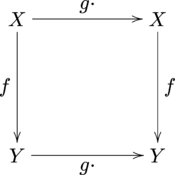Equivariant map
In mathematics, an equivariant map is a function between two sets that commutes with the action of a group. Specifically, let G be a group and let X and Y be two associated G-sets. A function f : X → Y is said to be equivariant if
- f(g·x) = g·f(x)
for all g ∈ G and all x in X. Note that if one or both of the actions are right actions the equivariance condition must be suitably modified:
- f(x·g) = f(x)·g ; (right-right)
- f(x·g) = g−1·f(x) ; (right-left)
- f(g·x) = f(x)·g−1 ; (left-right)
Equivariant maps are homomorphisms in the category of G-sets (for a fixed G). Hence they are also known as G-maps or G-homomorphisms. Isomorphisms of G-sets are simply bijective equivariant maps.
The equivariance condition can also be understood as the following commutative diagram. Note that  denotes the map that takes an element
denotes the map that takes an element  and returns
and returns  .
.

Intertwiners
A completely analogous definition holds for the case of linear representations of G. Specifically, if X and Y are the representation spaces of two linear representations of G then a linear map f : X → Y is called an intertwiner of the representations if it commutes with the action of G. Thus an intertwiner is an equivariant map in the special case of two linear representations/actions.
Alternatively, an intertwiner for representations of G over a field K is the same thing as a module homomorphism of K[G]-modules, where K[G] is the group ring of G.
Under some conditions, if X and Y are both irreducible representations, then an intertwiner (other than the zero map) only exists if the two representations are equivalent (that is, are isomorphic as modules). That intertwiner is then unique up to a multiplicative factor (a non-zero scalar from K). These properties hold when the image of K[G] is a simple algebra, with centre K (by what is called Schur's Lemma: see simple module). As a consequence, in important cases the construction of an intertwiner is enough to show the representations are effectively the same.
Categorical description
Equivariant maps can be generalized to arbitrary categories in a straightforward manner. Every group G can be viewed as a category with a single object (morphisms in this category are just the elements of G). Given an arbitrary category C, a representation of G in the category C is a functor from G to C. Such a functor selects an object of C and a subgroup of automorphisms of that object. For example, a G-set is equivalent to a functor from G to the category of sets, Set, and a linear representation is equivalent to a functor to the category of vector spaces over a field, VectK.
Given two representations, ρ and σ, of G in C, an equivariant map between those representations is simply a natural transformation from ρ to σ. Using natural transformations as morphisms, one can form the category of all representations of G in C. This is just the functor category CG.
For another example, take C = Top, the category of topological spaces. A representation of G in Top is a topological space on which G acts continuously. An equivariant map is then a continuous map f : X → Y between representations which commutes with the action of G.